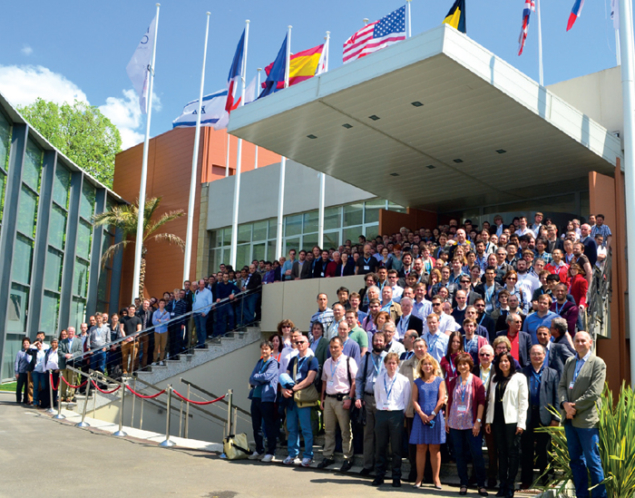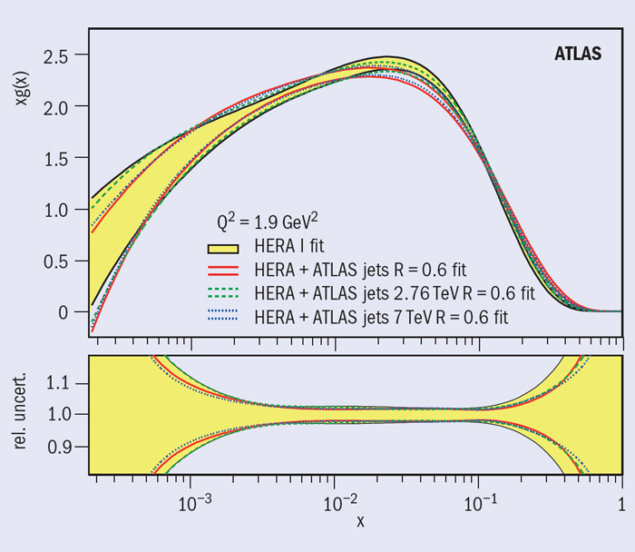A report from the latest workshop on deep-inelastic scattering.

Image credit: Dirk Hoffmann, CPPM.
The regular “DIS” workshops on Deep-Inelastic Scattering and related subjects usually bring together a unique mix of international communities and cover a spectrum of topics ranging across proton structure, strong interactions and physics at the energy frontier. DIS2013 – the 21st workshop – which took place in the Palais des Congrès in Marseilles earlier this year was no exception. Appropriately, this large scientific event formed part of a rich cultural programme in the city that was associated with its status as European Capital of Culture Marseilles-Provence 2013.
A significant part of the programme was devoted to recent and exciting experimental results, which together with theoretical advances and the outlook for the future created a vibrant scientific atmosphere. The workshop began with a full day of plenary reports on hot topics, followed by two and a half days of parallel sessions that were organized around seven themes: structure functions and parton densities; small-x, diffraction and vector mesons; electroweak physics and beyond the Standard Model; QCD and hadronic final states; heavy flavours; spin physics; future experiments.
Higgs and more
The meeting provided the opportunity to discuss in depth the various connections between strong interactions, proton structure and recent experimental results at the LHC. In particular, the discovery of a Higgs boson and the subsequent studies of its properties attracted a great deal of interest, including from the perspective of the connections with proton structure. A tremendous effort was made in the past year to provide an improved theory, study the constraints from the wealth of new experimental data and adopt a more robust methodology in analyses that determine the proton’s parton distribution functions (PDFs). The PDFs are an essential ingredient for most LHC analyses, from characterization of the Higgs boson to self-consistency tests of the Standard Model. The first “safari” into the new territory at the LHC and the impressive final results with the full data set from Fermilab’s Tevatron have revealed no new phenomena so far. However, it might well be that the search for new physics – which will be re-launched at higher energies during the next LHC run – will be affected by the precision with which the structure of the proton is known.
The goal of the spin community is to produce a 3D picture of the proton with high precision
The most recent experimental results from continuing analysis from HERA – the electron–proton collider that ran at DESY during 1992–2007 – were presented. In particular, both the H1 and ZEUS collaborations have now published measurements at high photon virtualities (Q2). While the refined data from HERA form its immensely valuable legacy, the transfer of the baton to the LHC has already begun. A large number of recent results – in particular from the LHC – provide further constraints on the PDFs, such as in the case of final states with weak bosons or top quarks, which are already in the regime of precision measurements with about 1% accuracy. Stimulated by an active Standard Model community that has many groups that are working on the determination of PDFs (such as ABM, MSTW and CTEQ) and by the release of common analysis tools such as HERAFitter, the new measurements from the LHC are rapidly interpreted in terms of valuable PDF constraints, as figure 1 shows. More exclusive final states have the potential to complement inclusive measurements: for instance, measurements on the W in association with the charm quark could shed new light on the strangeness content of the proton. A huge step in the precision of PDF determination – which might be essential to study new physics – complemented by a standalone programme at the energy frontier would be possible at the proposed Large Hadron Electron Collider (LHeC), which could provide a new opportunity to study Higgs-boson couplings.

The understanding of proton structure would not be complete without understanding its spin. Polarized experiments – including fixed-target DIS experiments at Jefferson Lab and CERN, as well as the polarized proton–proton programme at Brookhaven’s Relativistic Heavy-Ion Collider (RHIC) – continue to provide new data and to open new fields. The goal is to understand the parton contributions to the proton’s spin, long considered a “puzzle” because of the unexpected way that it is shared between the quarks – with only a quarter – the gluons and the relative angular momentum. Recent, more precise measurements of W-boson production in polarized proton–proton collisions at RHIC have the potential to constrain further the valence quark contributions, while semi-inclusive DIS scattering at fixed-target experiments (for instance, using final states with charm mesons) continue to reduce the uncertainty on the gluon contribution. The goal of the spin community – manifest in the project for a polarized Electron-Ion Collider (EIC) – is to produce a 3D picture of the proton with high precision using a large number of observables across an extended phase space.
Impressive precision
The current scientific landscape includes many experiments that are based on hadronic interactions, with the LHC taking these studies to the highest energies. These are reaching impressive, increasing precision across a large phase space, not only in final states with jets but also in more exclusive configurations including photons, weak bosons or tagged heavy flavours. The measurements performed in diffraction – by now a classical laboratory for QCD tests – are also available from the LHC in inclusive and semi-inclusive final states and enforce the global understanding of the strong interactions. An interesting case concerns double-parton interactions where the final state originates from not one but two parton–parton collisions – a contribution that in some cases can pollute final-state configurations (including bosons or Higgs production). Although the measurements are not yet precise enough to identify kinematical dependencies or parton–parton correlations, they are beginning to unveil this contribution, which may prove in future to be related to profound aspects of the proton structure, such as the generalized parton distributions and the proton spin.
A global picture and complete understanding of the strong force can only emerge by using all of the available configurations and energies. In particular, the measurements of the hadronic final states performed in electron–proton collisions at HERA and the refined measurements at the Tevatron provide an essential testing ground for the increasingly precise calculations. Figure 2 illustrates this statement, presenting measurements of the strong coupling from collider experiments – including the most recent measurements from the LHC.
The high-energy heavy-ion collisions at both RHIC and the LHC have been a constant source of new results and paradigms during the past few years and this proved equally true for the DIS2013 conference. Probes such as mesons or jets “disappear” when high densities of the collision fireball are reached. The set of such probes has been consolidated at the LHC, where the experimental capabilities and large phase space allow further measurements involving strangeness, charm or inclusive particle production. In addition, the recently achieved proton–lead collisions provide new testing grounds for the collective behaviour of the quarks and gluons at high densities.

A total of 300 talks were given covering the seven themes of the workshop, distributed across two and a half days of parallel sessions, a few of which combined different themes. As tradition requires at DIS workshops, the presentations were followed by intense debates on classic and new issues, including a satellite workshop on the HERAFitter project. On the last day, the working group convenors summarized the highlights of the rich scientific programme of the parallel sessions.
The conference ended with a session on future experiments, where together with upgrades of the LHC experiments and other interesting projects related to new capabilities for QCD-related studies (AFTER, CHIC, COMPASS, NA62, nuSTORM, etc.), the two projects for new colliders EIC and LHeC were discussed. Rolf Heuer, CERN’s director-general, presented the recently updated European Strategy for Particle Physics. The programme at the energy frontier with the LHC will be followed for at least 20 years and studies for further projects are ongoing. The conference ended with an inspiring outlook talk by Chris Quigg of Fermilab, with hints of a possible QCD-like walk on the new physics frontier. In the evening, Heuer gave a talk for the general public to an audience of more than 200 people on recent discoveries at the LHC.
In addition to the workshop sessions, participants enjoyed a dinner in the Pharo castle – with a splendid view of the old and new harbours of Marseilles – where they found out why the French national anthem is called La Marseillaise. There was also half a day of free time for most of the participants – except maybe for convenors who had to prepare their summary reports – with two excursions organized at Cassis and in the historic centre of Marseilles.
In summary, the DIS2013 workshop once again allowed an insightful journey around the fundamental links between QCD, proton structure and physics at the energy frontier – an interface that will continue to grow and create new research ideas and projects in the near future. The next – 22nd – DIS workshop will be held in Warsaw in April 2014.







